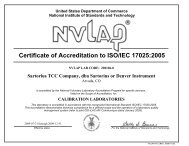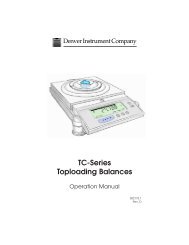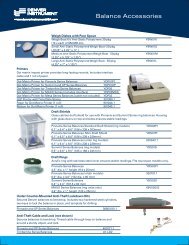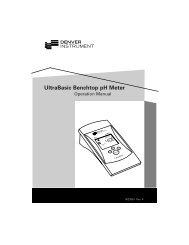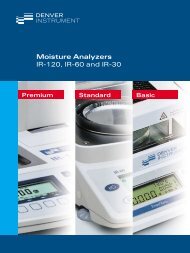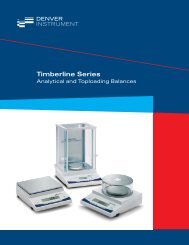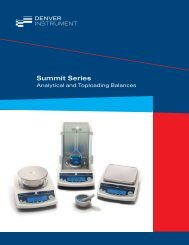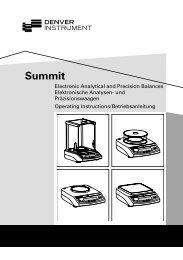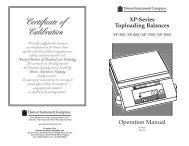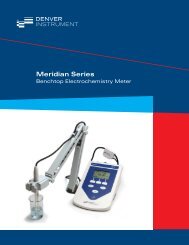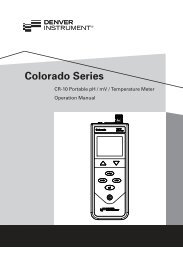Carbon Dioxide in Wines - Denver Instrument
Carbon Dioxide in Wines - Denver Instrument
Carbon Dioxide in Wines - Denver Instrument
Create successful ePaper yourself
Turn your PDF publications into a flip-book with our unique Google optimized e-Paper software.
<strong>Carbon</strong> <strong>Dioxide</strong> <strong>in</strong> W<strong>in</strong>esIntroduction<strong>Carbon</strong> dioxide (CO 2 ) is generally present <strong>in</strong> w<strong>in</strong>es. Thisis due to fermentation and the use of CO 2 for transferoperations dur<strong>in</strong>g w<strong>in</strong>emak<strong>in</strong>g. The pr<strong>in</strong>ciple is to makethe sample strongly alkal<strong>in</strong>e, by add<strong>in</strong>g concentratedsodium hydroxide solution that converts all the CO2<strong>in</strong>to CO 32- and titrat<strong>in</strong>g with 0.1M hydrochloric acid.Pr<strong>in</strong>cipleAs the w<strong>in</strong>e made strongly alkal<strong>in</strong>e (pH10-12) conta<strong>in</strong>sonly CO 32-, the titration occurs <strong>in</strong> two stepsCO 2- 3 + H+ HCO -3(end po<strong>in</strong>t at pH 8.6)HCO 3- + H+ CO2 + H 2 O(end po<strong>in</strong>t at pH 4.0)The end po<strong>in</strong>t titration is then performed with twosuccessive end po<strong>in</strong>ts (pH 8.6 and pH 4.0) and thetitrant volume delivered from pH 8.6 to pH 4.0 is usedto quantify theCO 2 level <strong>in</strong> the w<strong>in</strong>e <strong>in</strong> g/l. The molarweight of CO2 is 44.0 g/mol.A blank titration run with the same, but degassed, w<strong>in</strong>eis necessary.Electrode and ReagentspHC2401-8 Comb<strong>in</strong>ed pH Electrode(part no. E16M400)HCl 0.1 mol/l solution <strong>in</strong> distilledwater (see ApplicationNoteTTEP01-01MIN)This solution is also commerciallyavailable.NaOH 50% w/v <strong>in</strong> distilled waterDilution of 50 g of NaOH pellets <strong>in</strong> 100 ml of freshlyboiled distilled water is highly exothermic. The solutionis also very caustic for the sk<strong>in</strong> and eyes. Observelaboratory safety regulations.Distilled waterIn order to have a reproducibleblank result, use freshlyboiled, distilled water which has been cooled to roomtemperature.IUPAC Series pH standardspH 4.005 (part no. S11M002) and pH 10.012 (part no.S11M007)End Po<strong>in</strong>t Titration Sett<strong>in</strong>gsBurette volume:25 mlStirr<strong>in</strong>g speed:500 rpmWork<strong>in</strong>g mode:pHBlank:YES (see notes)Predose:0 ml (see notes)Stirr<strong>in</strong>g delay:10 secondsMaximum volume:40 mlM<strong>in</strong>imum speed:0.2 ml/m<strong>in</strong>Maximum speed:10 ml/m<strong>in</strong>Direction:Decreas<strong>in</strong>g pHNumber of end po<strong>in</strong>ts: 2End po<strong>in</strong>t 1:8.6 pHProportional band:2.0 pHEnd po<strong>in</strong>t delay:5 secondsEnd po<strong>in</strong>t 2:4.0 pHProportional band:2.0 pHEnd po<strong>in</strong>t delay:5 secondsSample unit:mlDilution:YESSample amount: 100F<strong>in</strong>al dilution amount: 102 (see notes)Aliquot: 10ResultNo of results: 1Result by:differenceCalculate with EP: 2Result unit:g/lMolar weight:44.0 g/molReaction:1 smp + 1 titrProcedureCalibrate the comb<strong>in</strong>ed pH electrode.Let the w<strong>in</strong>e coolto 5°CBlank preparationDegass<strong>in</strong>g a w<strong>in</strong>e sample. Pour the w<strong>in</strong>e <strong>in</strong>to aBuchner flask and connect it to a vacuum system for 3m<strong>in</strong>utes.Degass<strong>in</strong>g is also possible by heat<strong>in</strong>g the w<strong>in</strong>e andboil<strong>in</strong>g for few seconds only. Then allow the w<strong>in</strong>e tocool to room temperature. Pipette 100 ml of thisdegassed w<strong>in</strong>e; add 2 ml or more of the NaOH 50%solution as accurately as possible. Make sure that thepH of this solution is around pH 10-12. Pipette 10 ml ofthis solution. Add the necessary volume of distilledwater; dip electrode and delivery tip <strong>in</strong> the solution.Run a blank titration. You can run more than one teston the blank; <strong>in</strong> this case the Titration Manager takes
<strong>in</strong>to account the mean value.Sample preparationTak<strong>in</strong>g care not to lose carbon dioxide, take 100 ml ofthe w<strong>in</strong>e at 5°C us<strong>in</strong>g a measur<strong>in</strong>g tube. Pour it <strong>in</strong> aconical flask, add the same volume of the NaOH 50%solution as for the blank, seal the flask and mixthoroughly. To avoid los<strong>in</strong>g carbon dioxide, ensure thatthe flasks handl<strong>in</strong>g the sample are always at lowtemperature (near 0°C). Use an ice bath or refrigerator.Make sure that the pH of this solution is around pH 10-12. Pipette 10 ml of this solution. Add the necessaryvolume of distilled water, dip electrode and delivery tip<strong>in</strong> the solution. Run the titration.ResultsExpressed as g/l of CO2 (molar weight of CO 2 = 44g/mol)RCO2 = (Vtitr - Vblk) * Ctitr * 44 / VsmpVtitr = Delivered titrant volume between pH 8.6 and pH4.00 for sampleVblk = Delivered titrant volume between pH 8.6 and pH4.00 for blankCtitr = Titrant concentration <strong>in</strong> mol/l (generally 0.1)Vsmp = Sample volume (generally 10 ml)The above-mentioned END POINT SETTINGS take <strong>in</strong>account:- the blank calculation,- the dilution factor due to the addition of 2 ml ofNaOH 50% solution.Result on red w<strong>in</strong>eNo carbon dioxide measuredVerification of the method by addition of Na 2 CO 3directly <strong>in</strong> the sample beaker before titration with thesame w<strong>in</strong>e.Na2CO3 added <strong>in</strong> mg Vtitr - Vblk24 2.57 ml45 4.5 ml61 6.08 mlAs <strong>in</strong>dicated <strong>in</strong> this table the method allows the addedNa 2 CO 3 be measured with a recovery ratio close to98%.Results on sparkl<strong>in</strong>g white w<strong>in</strong>eSample dilution sett<strong>in</strong>gs for this w<strong>in</strong>eSample amount:50 mlF<strong>in</strong>al dilution amount: 52 mlAliquot:10 mlBlank on degassed w<strong>in</strong>e5.37 ml of titrant (mean on 3 determ<strong>in</strong>ations)Results (3 determ<strong>in</strong>ations)Mean:Standard deviation:6.83 g/l CO20.02 g/l CO2Work<strong>in</strong>g RangeAccord<strong>in</strong>g to the formula mentioned under "Results":1 ml for (Vtitr - Vblk) corresponds to 0.44 g/l of CO2Note that this result is calculated for 10 ml of sampleand does not take <strong>in</strong>to account the dilution factor dueto addition of NaOH 50% solution.NotesNote regard<strong>in</strong>g the "blank"As the behaviour of every w<strong>in</strong>e is different, it isnecessary to run a blank titration for every differenttype of w<strong>in</strong>e.As the blank titration depends on the composition ofthe studied w<strong>in</strong>e, do not forget to use the same sampleamount of w<strong>in</strong>e and dilution sett<strong>in</strong>gs for the blankdeterm<strong>in</strong>ation and for the sample.Note regard<strong>in</strong>g the "predose"To save time it is possible to use the "predose"function of the Titration Manager.Bear <strong>in</strong> m<strong>in</strong>d that the "predose" volume of titrant iseffective dur<strong>in</strong>g sample titration and also "blanktitration.Note that us<strong>in</strong>g "predose" can elim<strong>in</strong>ate the first endpo<strong>in</strong>t.Note regard<strong>in</strong>g the f<strong>in</strong>al amount dilutionThis amount is the sum of the volume sample(generally 100 ml) and the volume of the NaOH 50%solution added (<strong>in</strong> this application note 2 ml).The volume of the NaOH 50% can change accord<strong>in</strong>g tothe w<strong>in</strong>e.Note regard<strong>in</strong>g the resultAs the method itself offers good reproducibility, theaccuracy of the result depends on the handl<strong>in</strong>g ofthe non-degassed sample. It is important to avoidlos<strong>in</strong>g carbon dioxide especially with sparkl<strong>in</strong>g w<strong>in</strong>es.Ensure that a sufficient volume of NaOH 50% solutionis added.CurvesBlank
Sample: sparkl<strong>in</strong>g w<strong>in</strong>eBibliographyTechniques for chemical analysis and qualitymonitor<strong>in</strong>g dur<strong>in</strong>g w<strong>in</strong>emak<strong>in</strong>gEd: Patrick ILAND w<strong>in</strong>e promotionCampbelltown AUSTRALIA




